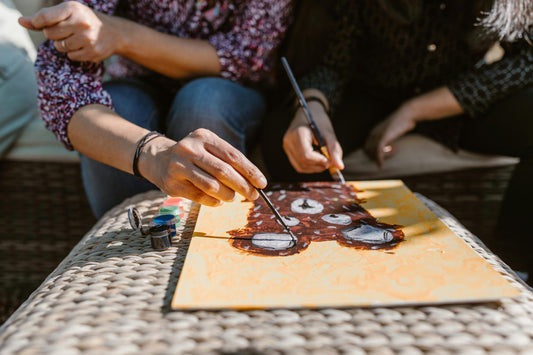Acrylic paint is a favorite among artists for its vibrant colors and fast-drying nature. However, that same quick-drying feature can sometimes turn into a nightmare if it dries on your paintbrushes. Whether you're a professional artist or a hobbyist using a paint by number kit (bonus points if it's a custom Passion Paints kit), keeping your brushes in top condition is essential for creating beautiful work. But what do you do when acrylic paint dries on your brushes? In this guide, we’ll cover the most effective ways to get dried acrylic paint out of brushes and restore them to their former glory.
Why Does Acrylic Paint Dry So Fast?
Acrylic paint is water-based and known for drying rapidly, which is great for creating art in layers but can lead to problems if left on your brushes for too long. Once the water in the paint evaporates, it forms a plastic-like coating, making it difficult to remove from brush bristles. The good news is, there are several methods you can use to clean your brushes, even if the paint has dried.
How to Get Dried Acrylic Paint Out of Brushes
Here are a few tried-and-true methods for removing dried acrylic paint from your brushes:
1. Use Rubbing Alcohol or Isopropyl Alcohol
Rubbing alcohol (or isopropyl alcohol) is a powerful solvent that can help break down dried acrylic paint.
Steps:
- Pour a small amount of rubbing alcohol into a container or cup.
- Submerge the dried bristles of the brush in the alcohol for about 10-20 minutes.
- Carefully massage the bristles with your fingers or use a brush comb to break up the paint.
- Once the paint has softened, rinse the brush thoroughly under warm water.
- Repeat the process if needed until all the paint is gone.
Rubbing alcohol can be harsh on brushes, so don’t leave the bristles soaking for too long. Be sure to condition the brush with soap or conditioner afterward to restore softness.
2. Use Acetone or Nail Polish Remover
Acetone, commonly found in nail polish remover, is another strong solvent that works well for dissolving dried acrylic paint.
Steps:
- Place a small amount of acetone into a container.
- Dip the dried part of the brush in acetone for a few minutes.
- Work the bristles with your fingers or a brush cleaner to remove the softened paint.
- Rinse the brush thoroughly under water to remove any residual acetone.
- Clean the brush with soap or brush cleaner to preserve the bristles.
Note: Acetone is very strong, so use it sparingly and avoid prolonged soaking. It can damage natural brushes if overused, but it’s effective in removing tough paint.
3. Try Using Brush Restorer
For those who frequently work with acrylic paint, investing in a commercial brush restorer can save a lot of headaches. Brush restorers are formulated to dissolve dried acrylic paint while protecting the bristles from damage.
Steps:
- Follow the instructions on the brush restorer bottle, as each product may vary.
- Typically, you’ll soak the brushes in the solution for a set period, which can be anywhere from 30 minutes to overnight.
- After soaking, gently work the bristles to lift away any loosened paint.
- Rinse the brush under warm water and clean it with soap to bring back its softness.
Brush restorer is an excellent option for artists who want a dedicated product that’s specifically formulated for saving dried-out brushes.
4. Use Dish Soap and Vinegar for a Natural Solution
If you’re looking for a natural method, vinegar and dish soap can help break down dried paint.
Steps:
- Heat a small pot of vinegar until it’s warm but not boiling.
- Submerge the brush bristles in the vinegar for about 10 minutes.
- Remove the brush and scrub it with a small amount of dish soap.
- Use your fingers to gently manipulate the bristles, helping to break up and loosen the paint.
- Rinse the brush with warm water, and repeat the process if needed for thorough cleaning.
This method is gentle and can be used as an eco-friendly alternative to harsh solvents.
5. Use Fabric Softener
Another household item that can help clean dried acrylic paint from brushes is fabric softener. It helps soften the dried paint, making it easier to remove.
Steps:
- Mix a solution of equal parts water and fabric softener in a container.
- Soak the brush in the solution for 30 minutes to an hour.
- Work the bristles with your fingers or a brush comb to remove the softened paint.
- Rinse thoroughly with water and wash with soap to ensure the bristles are clean.
This method works best for minor paint buildup and is less effective on thick layers of dried acrylic paint.
6. Don’t Forget to Condition Your Brushes
Once you’ve removed the dried paint, it’s important to condition your brushes to restore the softness and shape of the bristles. You can do this using a gentle soap, brush conditioner, or even a small amount of hair conditioner. Work it through the bristles, rinse thoroughly, and reshape the brush head before letting it air dry.
Tips for Preventing Acrylic Paint from Drying on Brushes
While it’s good to know how to clean dried acrylic paint from brushes, prevention is always better than a cure. Here are some tips to prevent paint from drying on your brushes in the first place:
-
Keep a Cup of Water Nearby: When working with acrylics, keep a cup of water next to your workspace. Frequently dip your brushes into the water to prevent the paint from drying on the bristles.
-
Use a Stay-Wet Palette: A stay-wet palette keeps the paint moist while you’re working, reducing the chance of the paint drying out quickly.
-
Clean Brushes Frequently: After finishing with each color, take a moment to rinse your brushes in water or brush cleaner to prevent buildup.




